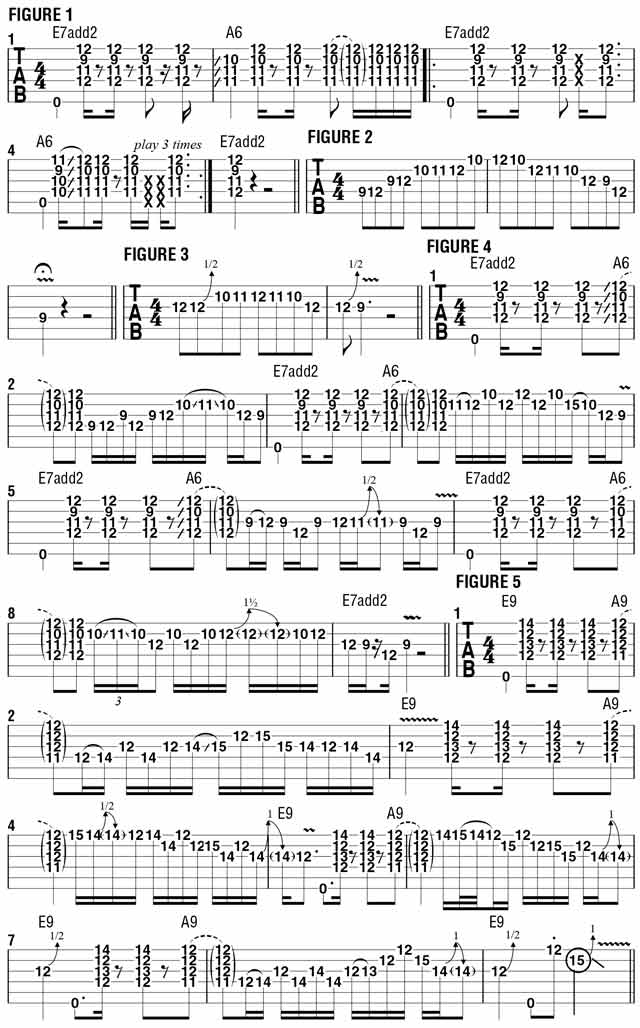Moving Up the Neck and Soloing Over Two-Chord Vamps

Two questions I hear most often from students are, “How can I become a better rhythm player?” and “How can I learn to connect different scale positions effectively when soloing?”
To me, these two aspects of playing embody virtually the same concept: whether you’re laying down a rhythm part or taking a solo, you should have the freedom to play musical ideas all over the fretboard without feeling confined in any way.
Just as one studies all the patterns associated with a specific scale for soloing, one must also study chord construction, inversions and chord types, to be able to improvise rhythm parts with the same feeling of authority and freedom as when soloing.
To address both issues, we’ve spent the last several columns examining a repeating I-IV (one-four) chord vamp and associated single-note lines, as played in a variety of positions. Our vamp is in the key of E, built from the one chord, E7, moving to the four chord, A7, then resolving back to E7. In each instance, the two chords have been sounded in a specific position, followed by single-note licks based on the E blues scale (E G A Bb B D) as played in that same area.
Additionally, we’ve included the major third, G#, in order to allow greater melodic flexibility while also eliciting a stronger connection to the E7 chord by sounding each note of its arpeggio (E G# B D). The resulting hybrid scale is E G G# A B Bb D, which includes the chromatic row G G# A Bb B.
FIGURE 1 illustrates a repeating E7-A7 rhythm pattern played in ninth/10th position. To add more harmonic variety, I’ve substituted E7add2 for E7 and A9 for A7. Once again, the open low E and A strings are used as pedal tones for each of the chords; when allowed to ring, they reinforce the harmonic relationship between a given single-note line and its associated chord. Now that the chord pattern in this position is established, let’s look at the E blues scale as played in this same position (see FIGURE 2).
As mentioned, bringing the major third, G#, into the mix, as shown in FIGURE 3, will tighten the connection between the chordal part and the single-note line. FIGURE 4 is a nine-bar example that offers different melodic patterns that fall between the E7add2 and A9 chords: when soloing in this position, the index finger is used for all notes fretted at the ninth and 10th frets, from which hammer-ons and slides are performed. Play through each of the phrases slowly and carefully, paying attention to the rhythmic syncopation inherent in each melodic shape.
In FIGURE 5, the concept is moved up to 12th position with the incorporation of E9 and A9 chords and single-note phrases based on the E blues scale, as played in that position, again with the inclusion of the major third, G#. Once you have these phrases down, use them as models for devising your own melodic lines and patterns.

Get The Pick Newsletter
All the latest guitar news, interviews, lessons, reviews, deals and more, direct to your inbox!
Guitar World Associate Editor Andy Aledort is recognized worldwide for his vast contributions to guitar instruction, via his many best-selling instructional DVDs, transcription books and online lessons. Andy is a regular contributor to Guitar World and Truefire, and has toured with Dickey Betts of the Allman Brothers, as well as participating in several Jimi Hendrix Tribute Tours.








![Joe Bonamassa [left] wears a deep blue suit and polka-dotted shirt and plays his green refin Strat; the late Irish blues legend Rory Gallagher [right] screams and inflicts some punishment on his heavily worn number one Stratocaster.](https://cdn.mos.cms.futurecdn.net/cw28h7UBcTVfTLs7p7eiLe.jpg)


